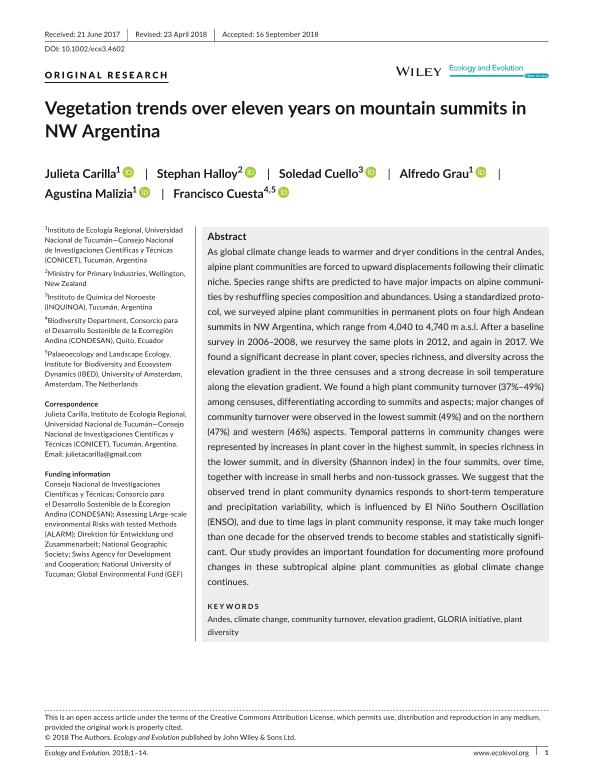Mostrar el registro sencillo del ítem
dc.contributor.author
Carilla, Julieta

dc.contributor.author
Halloy, Stephan

dc.contributor.author
Cuello, Ana Soledad

dc.contributor.author
Grau, Alfredo

dc.contributor.author
Malizia, Agustina

dc.contributor.author
Cuesta, Francisco
dc.date.available
2019-11-25T23:41:25Z
dc.date.issued
2018-12
dc.identifier.citation
Carilla, Julieta; Halloy, Stephan; Cuello, Ana Soledad; Grau, Alfredo; Malizia, Agustina; et al.; Vegetation trends over eleven years on mountain summits in NW Argentina; John Wiley & Sons Ltd; Ecology and Evolution; 8; 23; 12-2018; 11554-11567
dc.identifier.issn
2045-7758
dc.identifier.uri
http://hdl.handle.net/11336/90421
dc.description.abstract
As global climate change leads to warmer and dryer conditions in the central Andes, alpine plant communities are forced to upward displacements following their climatic niche. Species range shifts are predicted to have major impacts on alpine communities by reshuffling species composition and abundances. Using a standardized protocol, we surveyed alpine plant communities in permanent plots on four high Andean summits in NW Argentina, which range from 4,040 to 4,740 m a.s.l. After a baseline survey in 2006–2008, we resurvey the same plots in 2012, and again in 2017. We found a significant decrease in plant cover, species richness, and diversity across the elevation gradient in the three censuses and a strong decrease in soil temperature along the elevation gradient. We found a high plant community turnover (37%–49%) among censuses, differentiating according to summits and aspects; major changes of community turnover were observed in the lowest summit (49%) and on the northern (47%) and western (46%) aspects. Temporal patterns in community changes were represented by increases in plant cover in the highest summit, in species richness in the lower summit, and in diversity (Shannon index) in the four summits, over time, together with increase in small herbs and non-tussock grasses. We suggest that the observed trend in plant community dynamics responds to short-term temperature and precipitation variability, which is influenced by El Niño Southern Oscillation (ENSO), and due to time lags in plant community response, it may take much longer than one decade for the observed trends to become stables and statistically significant. Our study provides an important foundation for documenting more profound changes in these subtropical alpine plant communities as global climate change continues.
dc.format
application/pdf
dc.language.iso
eng
dc.publisher
John Wiley & Sons Ltd

dc.rights
info:eu-repo/semantics/openAccess
dc.rights.uri
https://creativecommons.org/licenses/by/2.5/ar/
dc.subject
ANDES
dc.subject
CLIMATE CHANGE
dc.subject
COMMUNITY TURNOVER
dc.subject
ELEVATION GRADIENT
dc.subject
GLORIA INITIATIVE
dc.subject
PLANT DIVERSITY
dc.subject.classification
Ecología

dc.subject.classification
Ciencias Biológicas

dc.subject.classification
CIENCIAS NATURALES Y EXACTAS

dc.title
Vegetation trends over eleven years on mountain summits in NW Argentina
dc.type
info:eu-repo/semantics/article
dc.type
info:ar-repo/semantics/artículo
dc.type
info:eu-repo/semantics/publishedVersion
dc.date.updated
2019-10-16T19:39:57Z
dc.journal.volume
8
dc.journal.number
23
dc.journal.pagination
11554-11567
dc.journal.pais
Estados Unidos

dc.journal.ciudad
Hoboken
dc.description.fil
Fil: Carilla, Julieta. Universidad Nacional de Tucumán. Instituto de Ecología Regional. Consejo Nacional de Investigaciones Científicas y Técnicas. Centro Científico Tecnológico Conicet - Tucumán. Instituto de Ecología Regional; Argentina
dc.description.fil
Fil: Halloy, Stephan. Ministry for Primary Industries; Nueva Zelanda
dc.description.fil
Fil: Cuello, Ana Soledad. Consejo Nacional de Investigaciones Científicas y Técnicas. Centro Científico Tecnológico Conicet - Tucumán. Instituto de Química del Noroeste. Universidad Nacional de Tucumán. Facultad de Bioquímica, Química y Farmacia. Instituto de Química del Noroeste; Argentina
dc.description.fil
Fil: Grau, Alfredo. Universidad Nacional de Tucumán. Instituto de Ecología Regional. Consejo Nacional de Investigaciones Científicas y Técnicas. Centro Científico Tecnológico Conicet - Tucumán. Instituto de Ecología Regional; Argentina
dc.description.fil
Fil: Malizia, Agustina. Universidad Nacional de Tucumán. Instituto de Ecología Regional. Consejo Nacional de Investigaciones Científicas y Técnicas. Centro Científico Tecnológico Conicet - Tucumán. Instituto de Ecología Regional; Argentina
dc.description.fil
Fil: Cuesta, Francisco. Consorcio para el Desarrollo Sostenible de la Ecorregión Andina; Ecuador. University of Amsterdam; Países Bajos
dc.journal.title
Ecology and Evolution
dc.relation.alternativeid
info:eu-repo/semantics/altIdentifier/url/https://onlinelibrary.wiley.com/doi/full/10.1002/ece3.4602
dc.relation.alternativeid
info:eu-repo/semantics/altIdentifier/doi/http://dx.doi.org/10.1002/ece3.4602
Archivos asociados
